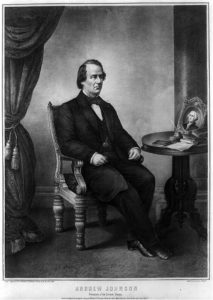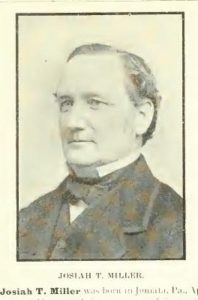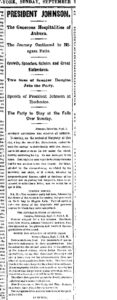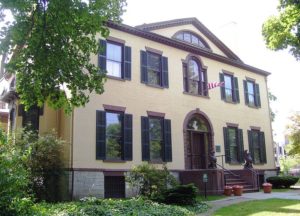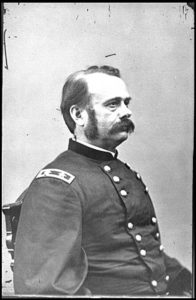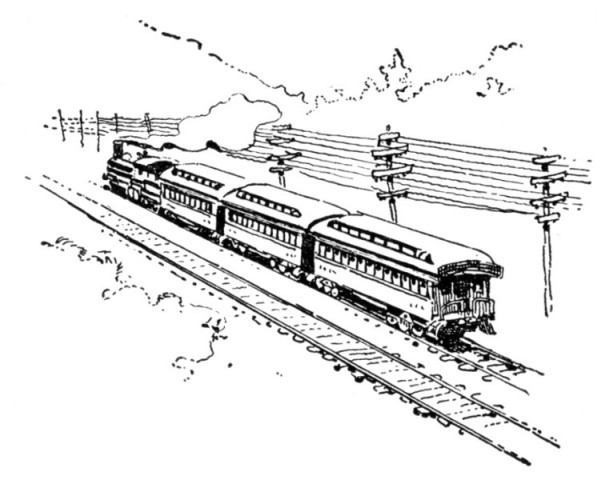On September 1, 1866 President Andrew Johnson’s swing around the circle tour stopped at a small town in the Finger Lakes region of New York. It was just a six minute stop as the train slowly progressed across the Empire State.
From a Seneca County, New York newspaper in 1866:
PRESIDENT JOHNSON IN SENECA FALLS. – On Saturday last President Johnson accompanied by Secretaries Seward and Welles, Gens. Grant, Custer and Rosseau [sic], Admiral Farragut and other distinguished personages, passed through this village, en route for Chicago, to participate in the ceremonies of laying the corner stone of the Douglas monument.
Some three or four thousand people assembled at the depot to pay honor to the President and suit. The east end of the freight house had been tastefully trimmed with flags and banners, the colors of the old 148th regiment attracting particular attention. The platform was kept clear by President Beary and the police, and upon the arrival of the train Gen. Miller, who accompanied the party from Auburn, stepped upon the platform followed by President Johnson, whom he welcomed in behalf of the authorities of the village. In the course of his remarks Gen. Miller said that “Seneca county had contributed more soldiers to the war in proportion, [sic] to the population than any other county in the State,” and he added that, in the same spirit, the true patriotic and Union-loving men of Seneca would rally in like majority, in defence of President Johnson and the Union. This elicited great cheering, and the President was received in a very enthusiastic manner.
President Johnson thanked the people in a very brief speech for the cordial welcome, and returned the cars. Gens. Grant and Custar [sic] and Admiral Farragut were then introduced. The people cheered them heartily, and after remaining on the platform a moment [,] they returned to the car, and the Presidential train moved on. The train did not stop here to exceed six minutes.
According to Walter Stahr the highlight of the tour for William H. Seward was the day before. The presidential train swung into the secretary’s hometown of Auburn, New York about 3:00 in the afternoon on August 31, 1866. The crowds were enthusiastic as the party proceeded from the train station to a park just south of Mr. Seward’s house, where the mayor welcomed President Johnson and his entourage. The group traveled farther south to Owasco Lake for “an open-air dinner, with many toasts and short speeches. After the dinner they returned to Auburn, where there were fireworks and Johnson was the house guest of Seward.” The next day the train gradually made its way to Niagara Falls.[1]
Auburn wasn’t so good for Ulysses S. Grant. The September 2, 1866 issue of The New-York Times reported that a boy eager to shake hands with General Grant shattered his leg when he fell under the wheel of the general’s carriage. The boy sent word to Secretary Seward that he still was anxious to meet the general. At 11:00 PM Grant and Surgeon General Joseph Barnes visited the boy at his home. General Grant told the boy to write him a letter when he recovered that Grant “might be of use to him.”
A.J. Langguth writes that overall the tour was bad for General Grant. “In Niles, Ohio, he was thrown to the ground when the speakers’ platform collapsed.” He didn’t seem to agree with President Johnson’s approach to the trip. Grant told General John Rawlins privately that he “did not choose to accompany a man who was deliberately digging his own grave.” General Grant drank heavily on the leg to Cleveland. Sylvanus Cadwallader and John Rawlins confined Grant to a baggage car until they arrived in Cleveland, where Grant and his drinking buddy Surgeon General Barnes were ferried to Detroit to await the president’s train. General Grant left the tour for good at St. Louis. *** [2]
The September 2nd Times article reports that the presidential entourage got off the train at 10:15 AM on September 1st in Canandaigua, New York, where Stephen A. Douglas studied for two years in his late teens. Caroline Cowles Richards made a note in her diary (page 207):
CANANDAIGUA, September 1.—A party of us went down to the Canandaigua hotel this morning to see President Johnson, General Grant and Admiral Farragut and other dignitaries. The train stopped about half an hour and they all gave brief speeches.
Lovell Rousseau served as a Union general in the western theater during the Civil War and “served valiantly at the Battles of Shiloh, Stones River, Chickamauga, during the Tullahoma Campaign and movements around Chattanooga, Tennessee.” General Rousseau represented Kentucky in the U.S. House for one term from 1865. Apparently during heated debate on the Freedmen’s Bureau Iowa Representative Josiah B. Grinnell challenged Rousseau’s war record. On June 14, 1866 Rousseau assaulted Grinnel in the Capitol: “Newspapers reported that while his armed supporters stood watch, Rousseau repeatedly struck the unarmed Iowan with an iron-tipped cane on the head and face until the cane broke. Grinnell emerged bruised but otherwise uninjured.” The House censured Rousseau, who resigned but was then re-elected by his constituents.
*** According to the September 11, 1866 issue of The New-York Times General Grant was with the entourage at least through an appearance at Indianapolis on September 10th.

